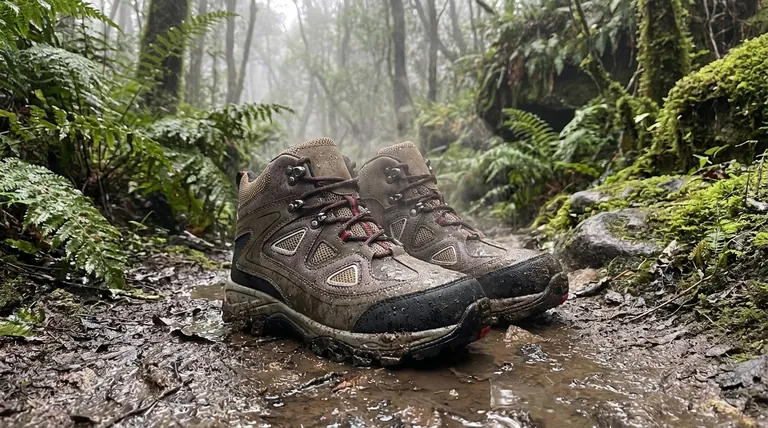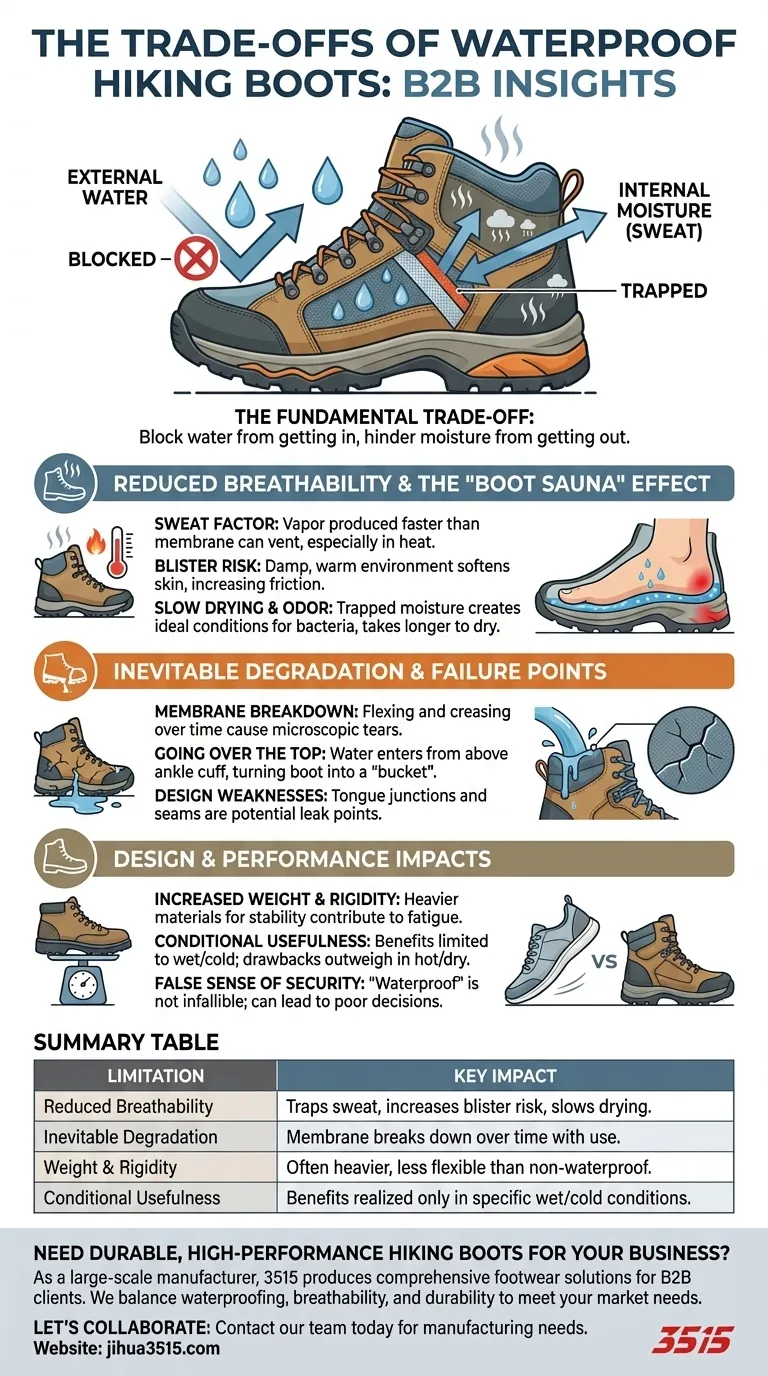At their core, the limitations of waterproof hiking boots stem from a fundamental trade-off: in the effort to block water from getting in, they inevitably hinder moisture from getting out. This leads to reduced breathability, trapped sweat, and a system that can fail over time or when completely submerged.
The central challenge with waterproof boots isn't just about keeping external water out, but about managing moisture from all sources—including your own feet. Their biggest limitation is that once moisture gets inside, whether from sweat or a deep puddle, it has a very hard time getting out.

The Breathability Problem: Trapping Moisture From Within
The technology that makes a boot waterproof is a membrane, like Gore-Tex, with pores too small for liquid water to pass through but large enough for water vapor (sweat) to escape. In practice, this system has significant limitations.
The Sweat Factor
During strenuous activity, your feet produce sweat vapor faster than the waterproof membrane can vent it. This is especially true in warmer or more humid conditions.
The membrane simply becomes overwhelmed, and the rate of moisture transfer drops significantly. This leads to a buildup of dampness inside the boot, even if no external water has entered.
The "Boot Sauna" Effect
When sweat can't escape, the inside of your boot becomes a warm, damp environment. This not only feels uncomfortable but also softens your skin, dramatically increasing the risk of friction and blisters.
Increased Odor and Drying Time
The lack of consistent air circulation in a waterproof boot creates an ideal environment for odor-causing bacteria to thrive.
Furthermore, once the inside of the boot is wet—either from sweat or from water getting in over the top—it takes significantly longer to dry out compared to a more breathable, non-waterproof alternative.
When "Waterproof" Fails: Letting Moisture From Without
No waterproofing system is infallible or permanent. Understanding its points of failure is crucial to relying on it correctly.
Inevitable Degradation
The waterproof membrane is subjected to constant flexing and creasing, particularly around the forefoot. Over time, this mechanical stress will cause the membrane to break down and develop microscopic tears, eventually leading to leaks.
Going Over the Top
A boot is only waterproof up to its ankle cuff. In a deep stream crossing or a sudden downpour, water can easily spill in over the top.
Once this happens, the boot’s lack of breathability turns it from a shield into a bucket, holding water against your foot for the remainder of your hike.
Design and Material Weaknesses
Not all "waterproof" designs are created equal. The area where the tongue connects to the boot's upper (the tongue junction or gusset) is a common weak point where water can seep in if not constructed perfectly.
Understanding the Trade-offs
Choosing a waterproof boot means accepting a specific set of compromises in exchange for protection from external moisture.
Weight and Rigidity
Waterproof boots often incorporate heavier materials and more rigid construction to support the waterproof membrane and provide stability. This can lead to increased fatigue on long hikes compared to lighter, more flexible footwear.
Not Always Necessary
The benefits of waterproofing are only realized in specific conditions. For hiking in dry, hot climates or on well-maintained trails in fair weather, the drawbacks of weight and poor breathability often outweigh the advantages.
The False Sense of Security
Relying too heavily on a boot being "waterproof" can lead to poor decisions, such as taking unnecessary risks with water crossings. It's a tool with limitations, not an impenetrable barrier.
Making the Right Choice for Your Hike
Your decision should be based on a realistic assessment of the conditions you'll face most often.
- If your primary focus is hiking in consistently wet, cold, or muddy terrain: A waterproof boot is the superior choice for keeping external moisture away from your feet.
- If your primary focus is hiking in hot, dry climates or on fair-weather days: A non-waterproof, highly breathable shoe will provide far greater comfort and prevent internal moisture buildup.
- If your primary focus is routes with frequent and deep water crossings: A fast-draining, non-waterproof trail runner paired with wool socks is often better, as it will dry out much faster after being fully submerged.
Ultimately, choosing the right footwear is about selecting the best tool for total moisture management, not just for waterproofing.
Summary Table:
| Limitation | Key Impact |
|---|---|
| Reduced Breathability | Traps sweat, increases blister risk, and slows drying time. |
| Inevitable Degradation | Waterproof membrane breaks down over time with use. |
| Weight & Rigidity | Often heavier and less flexible than non-waterproof options. |
| Conditional Usefulness | Benefits are only realized in specific wet/cold conditions. |
Need Durable, High-Performance Hiking Boots for Your Business?
As a large-scale manufacturer, 3515 produces a comprehensive range of footwear for distributors, brand owners, and bulk clients. We understand the delicate balance between waterproofing, breathability, and durability.
Our production capabilities encompass all types of boots, allowing us to tailor solutions that meet your specific market needs and performance requirements.
Let's collaborate to create the perfect footwear for your customers.
Contact our team today to discuss your manufacturing needs and how we can add value to your product line.
Visual Guide

Related Products
- Safety Footwear Wholesale Manufacturer for Custom OEM/ODM Production
- High Performance Fire-Retardant Waterproof Safety Boots
- Factory Direct Wholesale Rain Boots Durable Waterproof & Fully Customizable
- Premium Wholesale Waterproof Safety Boots High Performance Protection for Industrial Markets
- Wholesale High-Traction Camo Boots - Custom Manufacturer for Brands
People Also Ask
- What are OSHA approved shoes? Understanding the Correct Standards for Workplace Safety
- Do snake bite boots work? Your Ultimate Guide to Effective Snake Bite Protection
- What are the differences between steel toe, composite toe, and alloy toe Wellington boots? Choose the Right Safety Toe for Your Job
- What are the cultural perspectives on wearing shoes in the house? A Guide to Home Etiquette & Hygiene
- What cultural and environmental considerations are tied to wearing shoes indoors? Balance Hygiene, Tradition, and Foot Health



















